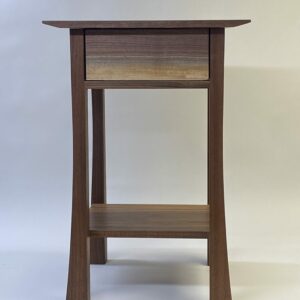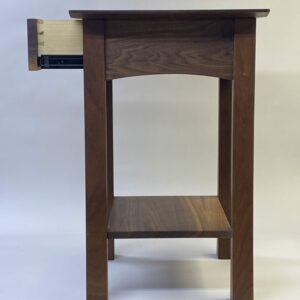Friends –
I have a nice little shop located in the basement of an old house. The only way in or out is via a set of narrow wooden stairs that end with a 90 degree turn. Large, heavy cast iron gear is not in the picture, as the stairs are narrow and rickety, and larger items won’t make the turn. Additionally, nothing wider than 22″ will make it out the door anyway. I did manage to get a 14″ bandsaw and the Ridgid 6 1/4″ cast iron jointer down there (with a lot of help), and I have tweaked the jointer to within a couple of thou. Rounding out the picture is a Dewalt 735 planer and Dewalt table saw. I’ve built co-planar in and outfeed tables for the planer and saw. Everything works pretty well, and I just finished an end table project that was 28 inches tall, with M&T joinery, tapered legs, etc., and everything came out perfectly (see photo).
I just started milling lumber for my first larger project, a coffee table that is 48″ long. What I’ve come to realize is that my jointer will probably not mill anything longer than 32-36″ to be perfectly flat, and I also just found out that over the last 3 years, my current planer sled (a sandwich of MDF, plywood, and hardboard) has gone out of flat. The only truly flat surface in the shop is one of the jointer tables, which maxes out at 22″. I spent the morning trying to mill a 48″ board, and currently have no way to do that and no perfectly flat reference edge long enough to check.
So, here is today’s question: should I build a torsion box planer sled, or a torsion box router flattening jig, or both, or something else? I would hate to limit my work to pieces that are 36″ or shorter, and I’m not eager to mill lumber by hand. I would like some way to mill longer boards and a way to check flatness.
Thanks for reading. I await replies. Thanks!!
















Replies
I don't have a jointer. I have the same DW735 planer. I can get wood flat enough for projects without any kind of sleds or jigs.
I don't buy twisted lumber. I just don't trust it,even if I mill it flat. It always wants to move. Cupped lumber comes out in the planer, easy peasy.
If I do need to knock a corner or two off before running a board through the planer, I do it with a jack plane.
You mention "perfectly flat." I never measure. If it's flat with a pair of winding sticks and my eyeballs, it's flat.
I fear you are facing a chicken / egg issue if you try to build a torsion box. Without a perfectly flat surface to build the TB on it won't be flat either. It sounds like the planer sled that is no longer flat needs replacing. If I was going to invest time in one of those machines I'd pick the planer.
I have used this method for years and have two of them a 24" and a 48". I made the 24 because it is lighter and don't always work with long stock.
A simple search on Fine Woodworking yielded some articles and videos:
https://www.finewoodworking.com/project-guides/shop-machines/turn-your-planer-into-a-jointer
https://www.finewoodworking.com/project-guides/shop-machines/a-planer-sled-for-milling-lumber
https://www.finewoodworking.com/project-guides/shop-machines/flatten-boards-without-a-jointer
https://www.finewoodworking.com/2020/01/02/how-to-flatten-boards-without-a-jointer
I’d build a new planer sled to support 48” work pieces.
+1 for new planer sled. I have the Dewalt 735 with the extension tables and a 4'x13" piece of melamine. In addition, I have lifters in all 4 corners of the melamine, a suitably sized bolt fitted into a t-nut in the table on which the planer sits. It keeps all 4 corners supported, preventing warpage.
I have been using my 735 for years and have never had a problem running a LOT of six foot or longer hard maple through it with no sled. I keep the infeed and outfeed tables adjusted flat and use a roller stand past the outfeed. One thing to consider is that all planers leave a bit of snipe at the end so I always leave some extra to cut off.
Have you thought about building longer infeed and outfeed tables for your jointer? Also, definitely scrap the non flat sled. Long pieces shouldn't need a sled. If the wood touches all the rollers, you don't really need a sled.
I make things out of wood and wood type materials. Wood changes shape. Jigs, straight edges or that thing you spent a lot of time on to make perfectly square made out of wood ,plywood mdf etc. all become untrustworthy in time. They have a short life expectation. I just make them new when required. If what I did once did what it was designed to do I just do the same thing again. If super high accuracy is what your after then that is what machine shops are for.
I have owned a Dewalt 735 for 10+ years and have never had a problem getting a board flat enough to use for any project, even before I owned a long bed 8" jointer (which kind of forced me to almost never flatten the first side of a board before planing.) Given this, I'm not sure why you would need a sled for the planer except for planing thin boards. If you have some boards that are twisted and/or cupped you might want to make a sled that allows you to shim the problem spots for getting one side flat. I also don't agree that you need a completely flat surface to build a flat sled for the planer. if it's a torsion box, as long as the sandwiched pieces are all ripped and/or cut to the same length or width, either using a stop for crosscuts or ripping them with the same setting on a table saw, I believe you would be able to create a flat sled using MDF and the pieces you cut for the middle.
Boards bend. It is difficult to check flatness of a board without setting it onto a flat surface. The longer the board, the longer that surface needs to be. Could be as simple as buying a door blank. A hollow-core door blank is basically a torsion box anyway - so its not a bad place to start. Butcher block counter tops can also be purchased for a slightly larger investment that are basically flat and very stable.
I also like to have a long straight-edge available. I have 6-ft and 10-ft 1/8" x 3" aluminum shear cuts that I got from a sheet metal shop. I keep them hanging on the center-beam of my shop where they are protected.